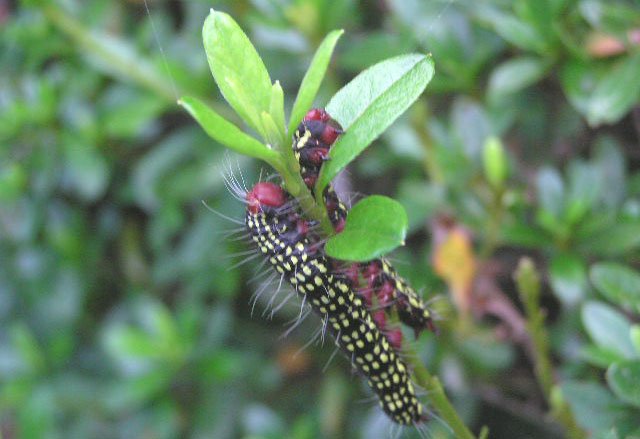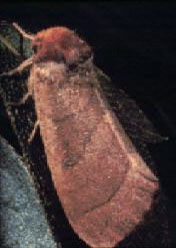Datana major
(Grote & Robinson, 1866)


The Azalea Caterpillar feeds on azalea. These caterpillars are frequently seen in the fall, feeding in groups on the tender leaves of their favourite host.
Despite their "hairy" appearance and stiking colouration, they are harmless to humans.
This species is found in "the southeastern quarter of the United States from Florida as far north as Maryland. The caterpillars seem to prefer indica azaleas, but have been reported on blueberry in Delaware, red oak in Maryland, and andromeda and apple in the mid-Atlantic states (Johnson and Lyon 1991)."
Chamaedaphne calyculata and Lyonia mariana have also been observed as hosts.
Jan Wiggs wrote,
"Hi,
"I'm exhausted from trying to locate which or what kind of caterpillars these are from the NET.
"Whenever you have time, if you don't mind, could you let me know what kind they are.
"I live in Raleigh, North Carolina, USA....... This is in the Piedmont (CENTRAL) part of North Carolina.
"These (plus a lot of friends) are devouring my azalea bushes. They love the new growth on them."
I wrote back indicating the species and suggested Janice flick them off the bush with her finger into a pail of water, to be followed with a flush.
In the spring, adult female moths lay masses of tiny white eggs (up to a hundred in a single group) on the undersides of host foliage.
Newly emerged larvae feed gregariously and skeletonize leaves which soon turn brown and drop from the bush several days later.
Mature larvae can reach lengths of two inches (50 mm) and tend to arch both the front and rear ends when disturbed.
The greatest feeding damage (mature larvae devour entire leaves and lots of them) is usually done in August and September, but in Florida, where there may be as many as two broods annually, the feeding frenzy sometimes continues into October.The moth is not nearly as colourful as the caterpillar. Wingspan of this pale brown species is about 1 3/4 inches (43 mm). Image courtesy of James Baker, North Carolina State University. |  |
Datana minor belongs to the Notodontidae family.
Return to the Main Index